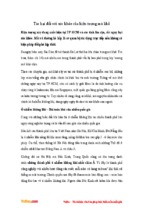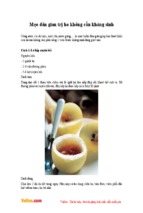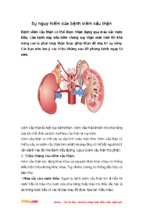Accessed from 128.83.63.20 by nEwp0rt1 on Tue Jun 05 05:20:29 EDT 2012
Second Supplement to USP 35–NF 30
General Information / 〈1088〉 In Vitro and In Vivo Evaluation 5663
In the event that the package cannot be delivered as
scheduled, the package should be returned to the mailing
pharmacy.
〈1088〉 IN VITRO AND IN VIVO
EVALUATION OF DOSAGE FORMS
Risk Management System
Risk Management System strategies should ensure that
each organization’s best interests are served by adhering to
proper practices, controls, and procedures, including but
not limited to the following: the nature of the drug products; distribution requirements on the readable container labeling; exposure to adverse environmental conditions; number of stages/receipts in the supply chain; manufacturer’s
written instructions; contractors; and drugs at risk from
freezing (vaccines, insulin, and biological products) or elevated temperatures (fatty-based suppositories, vaccines, insulin, and biological products).
Examples of risks include the following: (1) vibration that
can cause aggregation of some drug products such as proteins and peptide-based drugs; (2) temperature excursions
that may lead to phase changes (melting or freezing); (3)
loss of container–closure integrity in transit that could cause
glass fractures or loss of sterility in sterile drug product containers; and (4) ingress of water or oxygen that could lead
to an increase in degradation products. Appropriate firms
such as applicant holders are recommended to convey relevant environmental requirements when needed to support
deviations or excursions. There may be alternate ways of
determining acceptable environmental conditions and these
should be documented and justified.
Pharmaceutical manufacturers should ensure that suppliers
of drug product transportation are monitored. Auditing
transportation firms should be carried out routinely to ensure adequate product handling. The manufacturer’s change
control system should capture and evaluate changes in logistic factors such as warehouse or receiving areas and vehicle changes.
CONCLUSION
The practices and processes set forth in this general information chapter apply to storage and distribution as part of
the life-cycle management of drug products. All involved
should ensure the product to its point of use, creating a
contiguous supply network that is collaborative and emphasizes preventive measures to protect drug product quality.
The increase in global processes coupled with products requiring special environmental controls highlights the need
for a strong QM program. QM should provide the foundation for maintaining the storage and distribution practices in
a continual improvement program and part of an overall
management system review by each entity, as appropriate,
in the supply chain.
It is equally important to stay current and be ready to
change as new solutions evolve. These new technologies
should be considered in developing strategies for good distribution practices, controls, and procedures.■2S (USP35)
Change to read:
■
PURPOSE
This chapter provides an overview of the methodology for
characterizing the physicochemical properties of a drug substance as well as its associated drug product and discusses
the relationship of these methods and properties to the
pharmacokinetic and pharmacodynamic properties of the
drug product. Results of in vitro methods are linked with
information from in vivo evaluations through an in vitro–in
vivo correlation (IVIVC).
SCOPE
The ultimate goal of these characterization studies is an
understanding of the relationship between the physicochemical and pharmacological properties of the drug substance to the pharmacokinetic properties and in vitro performance of the drug product. This chapter outlines the in
vitro and in vivo testing that goes into the development of
the body of data that informs decision making relating to
the formulation, manufacturing, and related regulatory activities necessary for the development, regulatory approval,
and marketing of any drug product. The chapter complements the information in general chapters, Assessment of
Drug Product Performance—Bioavailability, Bioequivalence, and
Dissolution 〈1090〉 and The Dissolution Procedure: Development and Validation 〈1092〉 by detailing the essential in vitro
and in vivo data elements underlying an understanding of
bioequivalence and bioavailability. The chapter text recognizes that regulatory guidances and a wealth of text books
are available to elaborate on the content provided, and it is
not the purpose to provide an exhaustive disquisition on the
subjects presented but rather to provide a guide and listing
of the issues of interest.
BACKGROUND INFORMATION
Establishing a meaningful relationship between dissolution
behavior and in vivo drug performance (i.e., IVIVC) has long
been sought from the perspectives of both bioavailability
(BA) and bioequivalence (BE) and quality control considerations. In setting dissolution acceptance criteria for a product
monograph, USP’s policy has been to give predominant
consideration to valid BA or BE studies, when available.
The earliest achievable in vitro characteristic thought to
predict an acceptable in vivo performance was tablet and
capsule disintegration. A test for disintegration was adopted
in USP XIV (1950). At that time, no quantitative work was
done to attempt to demonstrate such a relationship, especially with regard to in vivo product performance. Advances
in instrumental methods and analytical precision ultimately
opened up prospects for this work. The USP–NF Joint Panel
on Physiologic Availability recognized that the disintegration
test was insufficiently sensitive and in 1968 directed the
identification of candidate articles for the first 12 official dissolution tests that used Apparatus 1.
USP requires drug release testing via the USP performance
test in the majority of monographs for non-solution oral,
sublingual, and transdermal dosage forms. In the current
state of science, in vivo testing is necessary during the development and evaluation of both immediate-release and
Official from December 1, 2012
Copyright (c) 2012 The United States Pharmacopeial Convention. All rights reserved.
Accessed from 128.83.63.20 by nEwp0rt1 on Tue Jun 05 05:20:29 EDT 2012
5664 〈1088〉 In Vitro and In Vivo Evaluation / General Information
modified-release dosage forms. In some cases, depending
on the Biopharmaceutics Classification System (BCS) classification of the drug, and depending on regulatory policy, in
vivo testing may not be necessary. The special sensitivity of
the dissolution test to changes in composition or method of
manufacturing that do not result in significant changes in
performance in vivo is well recognized. An understanding of
the full complement of information given by in vitro and in
vivo evaluation of the drug substance and product is the
starting point in the development of a meaningful in vitro
performance test.
IN VITRO EVALUATION
Physicochemical Properties—Drug Substance
Physicochemical information typically includes polymorphism, stability, particle size distribution, solubility, dissolution rate, lipophilicity, permeability, and other release-controlling variables of the drug substance under conditions
that may mimic the extremes of the physiologic environment experienced by the dosage form.
Physicochemical Properties—Drug Product
The variables tested to characterize the physicochemical
properties of the drug product should be the same as those
that are tested to characterize the drug substance. Dissolution profiles over a relevant pH range, usually from pH
1–6.8, should be obtained with particular attention to formulation effects. Characterization of formulations that are
insoluble in aqueous systems may require the addition of
sodium lauryl sulfate or another surfactant. The BCS classification of the drug substance should be determined, especially for immediate-release dosage forms.
Dissolution Testing
Dissolution testing is required for all non-solution oral, including sublingual, Pharmacopeial dosage forms in which
absorption of the drug is necessary for the product to exert
the desired therapeutic effect. Exceptions include tablets
that meet a requirement for completeness of solution, products that contain radiolabeled drugs, or products that contain a soluble drug and demonstrate rapid (10–15 min) disintegration. Dissolution testing should be conducted on
equipment that conforms to the requirements in Dissolution
〈711〉 and on which a performance verification test has been
conducted when one is available. On its website, USP provides a guidance for optimizing dissolution instrument performance by mechanical calibration and performance verification testing (http://www.usp.org/pdf/EN/
dissolutionProcedureToolkit2010-03.pdf).
In vitro dissolution testing generally should attempt to
mimic in vivo dissolution, but such in vitro conditions cannot be selected reliably a priori. A range of in vitro dissolution test conditions (e.g., media of varying pH, surfactant,
and apparatus rotational speed) should be evaluated.
Knowledge of drug substance properties, product formulation, gastrointestinal physiology, in vitro dissolution, and in
vivo pharmacokinetics will aid in the selection of in vitro
dissolution test conditions and specifications.
For products that contain more than a single active ingredient, dissolution typically should be determined for each
active ingredient. When a dissolution test is added to an
existing monograph, the disintegration test is deleted, but
in the case of sublingual preparations and orally disintegrating tablets, disintegration may be a critical quality attribute
in addition to dissolution. In such cases one or both tests
can be included in the monograph.
Second Supplement to USP 35–NF 30
When a single set of specifications cannot be established
for multisource products described in monographs, multiple
dissolution tests are allowed, and labeling is required to indicate the appropriate dissolution test for the specific
product.
Detailed information about method development and validation can be found in The Dissolution Procedure: Development and Validation 〈1092〉.
IMMEDIATE-RELEASE DOSAGE FORMS
For immediate-release dosage forms the in vitro dissolution process typically requires no more than 60 min, and in
most cases a single time-point specification is adequate for
Pharmacopeial purposes. To allow for typical disintegration
times, test times of less than 30 min should be based on
demonstrated need.
EXTENDED-RELEASE DOSAGE FORMS
For extended-release products in vivo dissolution generally
is rate limiting, which results in protracted drug absorption
and thus facilitates the identification of in vitro test conditions that may be predictive of in vivo dissolution. Multiple
sampling time points, therefore, are necessary to define a
dissolution profile for a modified-release dosage form.
The choice of apparatus should be based on knowledge
of the formulation and actual dosage form performance in
the in vitro test system. Apparatus 1 (basket) or Apparatus 2
(paddle) may be more useful at higher rotation rates (e.g.,
the paddle at 100 rpm). Apparatus 3 (reciprocating cylinder)
has been especially useful for bead-type modified-release
dosage forms. Apparatus 4 (flow cell) may offer advantages
for modified-release dosage forms that contain active ingredients that have limited solubility. Apparatus 7 (reciprocating
disk) is applicable to nondisintegrating oral modified-release
dosage forms, as well as to transdermal dosage forms. Apparatus 5 (paddle over disk) and Apparatus 6 (cylinder) also
are useful for evaluating and testing transdermal dosage
forms.
At least three timepoints are chosen to characterize the in
vitro drug release profile of an extended-release dosage
form for Pharmacopeial purposes. Additional sampling times
may be required for drug approval purposes. An early time
point, usually 1–2 h, is chosen to show that dose dumping
is not probable. An intermediate time point is chosen to
define the in vitro release profile of the dosage form, and a
final time point is chosen to show essentially complete release of the drug.
IN VIVO EVALUATION OF DOSAGE FORMS
In evaluating a drug product‘s performance, analysts fundamentally must ask what type of study should be performed to give reasonable assurance of BE of a marketed
product to the clinical trial product that demonstrated safety
and efficacy. Although they provide important information
concerning the release characteristics of the drug from the
dosage form, in vitro dissolution studies at present are used
primarily for setting or supporting specifications for drug
products (e.g., shelf life) and manufacturing process control
(e.g., scale-up or postapproval changes). Normally BE is best
demonstrated by in vivo evaluation but can sometimes be
replaced by in vitro studies.1 BE assessment of modified-release dosage forms is best achieved by observing in vivo
drug pharmacokinetic and/or pharmacodynamic behavior
by means of well-designed clinical studies. Multiple guidances for the conduct of such studies are provided by regulatory agencies. Moreover, when a well-defined, predictive
relationship exists between plasma concentrations of a drug
21 CFR 320.22 Criteria for waiver of evidence of in vivo bioavailability or
bioequivalence.
1
Official from December 1, 2012
Copyright (c) 2012 The United States Pharmacopeial Convention. All rights reserved.
Accessed from 128.83.63.20 by nEwp0rt1 on Tue Jun 05 05:20:29 EDT 2012
Second Supplement to USP 35–NF 30
General Information / 〈1088〉 In Vitro and In Vivo Evaluation 5665
or its active metabolites and the clinical response (therapeutic and adverse), it is possible to use plasma drug concentration data alone as a basis for the approval of a modifiedrelease dosage form that is designed to replace an immediate-release dosage form.
Although human pharmacokinetic studies often are used
to assess BE of immediate-release solid oral dosage forms, in
some cases in vitro studies can be used to assess BE. The
principal advantage of in vitro studies is that they reduce
development costs. For example, an in vitro test is preferable when one is testing BCS Class I drugs with rapid dissolution. Some regulatory agencies permit this type of testing in
lieu of in vivo testing.
The following discussions are intended to provide guidance for drug substance evaluation and the design, conduct, and evaluation of studies involving dosage forms. Although these guidelines focus on oral drug delivery systems,
the principles may be applicable to other routes of drug
administration (e.g., transdermal, subcutaneous, intramuscular, etc.).
CHARACTERIZATION OF DRUG SUBSTANCE
The Biopharmaceutics Classification System
(BCS)
FDA has issued a guidance titled “Waiver of In Vivo
Bioavailability and Bioequivalence Studies for Immediaterelease Solid Oral Dosage Forms Based on a Biopharmaceutics Classification System” (www.fda.gov/downloads/
Drugs/GuidanceComplianceRegulatoryInformation/Guidances/UCM070246.pdf). A key assumption in the approach
is that drug release and dissolution is sufficiently rapid so
that an in vitro–in vivo correlation is not possible and/or
useful. When applicable, the BCS allows dissolution rate
data in lieu of BA or BE studies for product approval.
2. Linearity or characterization of nonlinearity over the
dose or concentration range that could be
encountered.
3. Drug/metabolite accumulation.
4. Metabolic profile and excretory pathway, with special
attention to the active metabolites and active enantiomers of racemic mixtures.
5. Enterohepatic circulation.
6. Protein-binding parameters and effect of dialysis.
7. The effects of age, gender, race, and relevant disease
states.
8. Plasma: blood ratios.
9. A narrow therapeutic index or a clinical response that
varies significantly as a function of the time of day
(chronopharmacokinetics).
Pharmacodynamic Properties
Before developing a dosage form, analysts should obtain
concentration–response relationships over a dose range sufficiently wide to encompass important therapeutic and adverse responses. In addition, the equilibration-time2 characteristics between plasma concentration and effect should be
evaluated. For modified-release products that typically have
larger drug doses in the dosage form, these concentration–response relationships should be sufficiently characterized so that a reasonable prediction of the safety margin
can be made if dose dumping should occur. If there is a
well-defined relationship between the plasma concentration
of the active drug substance or active metabolites and the
clinical response (therapeutic and adverse), the clinical performance of a new modified-release dosage form could be
characterized by plasma concentration–time data. If such
data are not available, clinical trials of the modified-release
dosage form should be carried out with concurrent
pharmacokinetic and pharmacodynamic measurements.
CHARACTERIZATION OF THE DOSAGE FORM
Pharmacokinetic Properties
Analysts should thoroughly characterize the input absorption profile of the active drug entity from a formulation that
shows rapid BA (an intravenous solution, oral solution, or a
well-characterized immediate-release drug product). In turn,
this formulation serves as a reference to evaluate the input
profile of the modified-release dosage form. This information, together with the pharmacokinetics of the active drug
entity, can characterize drug absorption and can predict
changes in drug BA when input is modified as in modifiedrelease dosage forms. For example, if the active drug entity
exhibits saturable first-pass hepatic metabolism, a reduction
in systemic availability could result after oral administration
if the input rate is decreased.
In designing an oral modified-release dosage form, analysts may find it useful to determine the absorption of the
active drug entity in various segments of the gastrointestinal
tract, particularly in the lower gastrointestinal tract (colon)
for delayed-release dosage forms that release drug in this
region. Food effects also may be important and should be
investigated.
Drug Disposition
The information required to characterize drug disposition
may include the following.
1. Disposition parameters—clearance, area under the
time—plasma concentration curve (AUC), maximum
plasma concentration (Cmax), time to maximum
plasma concentration (Tmax), volume of distribution,
half-life, mean residence time, or model-dependent
parameters.
Pharmacokinetic Properties: ImmediateRelease Products
The types of pharmacokinetic studies that should be conducted are based on how much is known about the active
drug substance, its clinical pharmacokinetics, and its BCS
Class. For example, a new chemical entity requires greater
pharmacokinetic characterization than does an FDA-approved formulation that is undergoing scale-up and postapproval changes (SUPAC) evaluation.
The latter is seen when an FDA-approved drug product
undergoes changes in the manufacturing of the product after the product has been approved. Such changes are common and can be caused by expansion in the size of the lots
manufactured, new manufacturing locations, or the introduction of new technology. Necessary in vitro dissolution
tests and/or in vivo BE tests are described in the FDA “Guidance for Industry: Immediate-release Solid Oral Dosage
Forms: Scale-up and Postapproval Changes: Chemistry,
Manufacturing, and Controls, In Vitro Dissolution Testing,
and In Vivo Bioequivalence Documentation” (www.fda.gov/
downloads/Drugs/GuidanceComplianceRegulatoryInformation/Guidances/UCM070636.pdf).
Equilibration time is a measure of the time-dependent discontinuity between
measured plasma concentrations and measured effects. The discontinuity is
more often characterized by the degree of hysteresis observed when the effect-concentration plot for increasing concentrations is compared with that
for decreasing concentrations. Where the equilibration time is very short (i.e.,
rapid equilibration with no active metabolites generated), there will be little
or no hysteresis. That is, the same effect will be observed for a given concentration independent of the interval between the time of dosing and the time
that measurements are made.
2
Official from December 1, 2012
Copyright (c) 2012 The United States Pharmacopeial Convention. All rights reserved.
Accessed from 128.83.63.20 by nEwp0rt1 on Tue Jun 05 05:20:29 EDT 2012
5666 〈1088〉 In Vitro and In Vivo Evaluation / General Information
Similar requirements apply to a generic equivalent of an
approved immediate-release dosage form that must be BE
to the innovator drug, known as the reference listed drug.
The two most frequently used methods for meeting bioequivalence requirements are in vivo pharmacokinetic studies
and BCS-based in vitro studies.
Pharmacokinetic Properties: Modified-Release
Products
Like the approaches for immediate-release products, the
types of pharmacokinetic studies that should be conducted
for modified-release products are based on how much is
known about the drug substance, its pharmacokinetics, biopharmaceutics, and whether pharmacokinetic studies are
intended to be the sole basis for product approval. At a
minimum, two studies are required to characterize the product when no reference modified-release product exists: (1) a
single-dose crossover study for each strength of a modifiedrelease dosage form and (2) a multiple-dose, steady-state
study using the highest strength of a modified-release dosage form. A food effects study to evaluate the potential for
dose dumping from extended-release dosage forms also is
required as a separate study or is included as an arm of a
crossover study. In the demonstration of interchangeability,
a single-dose, fasting crossover study vs. the reference product usually will suffice. In some cases, a food-effects study is
required if the reference product has demonstrated a food
effect on BA. Some appropriate single-dose crossover and
multiple-dose steady-state studies are described below.
For modified-release products, intravenous solutions, oral
solutions, or well-characterized immediate-release drug
products are possible reference products to evaluate a modified-release formulation. For example, if the active drug entity exhibits saturable first-pass hepatic metabolism from the
small intestine, a reduction in systemic availability could result after oral administration if the input rate is decreased.
An increase in systemic availability could be observed if a
drug is absorbed from the colon from a delayed-release dosage form that targets the colon, thus avoiding a first-pass
effect.
In some modified-release capsule dosage forms, the
strengths differ from each other only in the amount of identical beaded material contained in each capsule. In this case,
single-dose and multiple-dose steady-state studies at the
highest dosage strength are sufficient. Other strengths can
be characterized on the basis of comparative in vitro dissolution data.
The pharmacokinetic studies described below are needed
for most modified-release dosage forms. These studies may
be the basis for characterization of the dosage form. If regulatory approval is sought without conducting clinical trials,
manufacturers should consult with the regulatory authorities
to ensure that an adequate database exists for the approval.
The types of pharmacokinetic studies generally conducted
can be categorized as follows.
CASE A
Case A applies to an original modified-release oral dosage
form for a drug already marketed in an immediate-release
dosage form and for which extensive pharmacokinetic/pharmacodynamic data exist.
Single-dose crossover study: A single-dose crossover
study should include the following treatments: the modifiedrelease dosage form administered under fasting conditions;
a dosage form that is rapidly available administered under
fasting conditions; and the modified-release dosage form
administered immediately after a high-fat standardized
meal. The food effects study should control the ambienttemperature fluid intake (e.g., 6–8 oz.) at the time of drug
administration. The dosage form should be administered
within 5 min after completion of the meal. Ideally all sub-
Second Supplement to USP 35–NF 30
jects should consume the meal in approximately 15 min. If
there are no significant differences in the rate or extent of
bioavailability (AUC, Cmax, and Tmax) as a function of the
meal, then additional food effect studies are not necessary.
If significant differences in bioavailability are found, researchers must define how food affects the modified-release dosage form,3 as well as how the food–drug effect relates to
time.
Use the following guidelines in evaluating food effects.
1. If no well-controlled studies have previously defined
the effects of a concurrent high-fat meal on an immediate-release dosage form, studies should be performed to determine whether a food effect is a result
of problems with the dosage form. Does the dosage
form show food-related changes in release, or are
there food effects that are unrelated to the dosage
form, e.g., changes in the drug’s absorption from the
gastrointestinal tract or changes in the drug’s disposition that are independent of absorption? The cause of
the food effect should be determined by a singledose crossover study comparing the solution (or immediate-release dosage form) under fed and fasting
conditions. If there is no food effect, then one concludes that there are problems with the dosage form.
If there is a food effect, then one concludes that the
effect is unrelated to the dosage form.
2. The influence of timing on the food effect should be
tested by a four-way crossover study, in which the
modified-release dosage form is administered under
the following treatment conditions: fasting, taken
with a high-fat meal, 1 h before a high-fat meal, and
2 h after a high-fat meal.
3. If the food effect on an immediate-release dosage
form is determined to result from changes in the dissolved drug’s absorption from the gastrointestinal
tract or from changes in drug disposition, studies
should define the appropriate relationship between
drug dosing and meals.
4. Alternative appropriate studies can be conducted if
the applicant labels the drug for administration with a
meal that is not fat loaded. In this case, an alternative
meal composition should be considered.
5. Analysts should monitor the entire single-dose, modified-release absorption profile. Where appropriate
(e.g., in a multiple-dose study) for specific drugs and
drug delivery systems, blood samples should be taken
following breakfast on the second day, before the
second dose is administered. This sampling schedule
is particularly important for once-a-day products.
6. For delayed-release (enteric-coated) dosage forms,
analysts should perform BA studies to characterize
food effect and to support the dosing claims stated in
the labeling.
The purpose of these studies is twofold: first, to determine
whether a need exists for labeling instructions describing
special conditions for administration with respect to meals;
and second, to provide information concerning the pattern
of absorption of the modified-release dosage form compared to that of the immediate-release dosage form. Drug
input function should be defined for modified-release dosage forms. This will aid in the development of an appropriate in vitro dissolution test. For dosage forms that exhibit
high variability, a replicate study design is recommended.
Multiple-dose, steady-state studies
Study I—When data demonstrating linear pharmacokinetics
exist for an immediate-release dosage form, a steady-state
study should be conducted with the modified-release dosage form at one dose rate (preferably at the high end of the
usual dosage regimen) using a comparable total daily dose
of an immediate-release dosage form as a control. At least
three trough plasma drug concentration (Cmin) determinations at the same time of day should be made to demonWagner–Nelson, Loo–Riegelman, and other deconvolution methods are
found in textbooks on biopharmaceutics.
3
Official from December 1, 2012
Copyright (c) 2012 The United States Pharmacopeial Convention. All rights reserved.
Accessed from 128.83.63.20 by nEwp0rt1 on Tue Jun 05 05:20:29 EDT 2012
Second Supplement to USP 35–NF 30
General Information / 〈1088〉 In Vitro and In Vivo Evaluation 5667
strate that steady-state conditions have been achieved.
Plasma drug concentration determinations, over at least one
dosing interval of the modified-release dosage form, should
be made in each phase of the crossover study. It may be
preferable (as in the case of rhythmic variation in absorption
or disposition of the drug) to measure concentrations over
an entire day in each phase. The presence or absence of
circadian variation should be verified. The modified-release
dosage form should produce an AUC that is equivalent to
that of the immediate-release dosage form if the extent of
absorption from the modified-release dosage form is comparable to the immediate-release dose. The degree of fluctuation for the modified-release product should be the same as,
or less than, that for the immediate-release dosage form
given by the approved regimen. Appropriate concentration
measurements should include unchanged drug and major
active metabolites. For racemic drug entities, analysts should
consider measurement of the active enantiomers.
Study II—When comparisons of the pharmacokinetic properties of an immediate-release dosage form at different doses
are not available, or when the data demonstrate nonlinearity, steady-state crossover studies comparing effects of
the modified-release dosage form and those of the immediate-release dosage form should be conducted at two different dose rates: one at the low end of the recommended
dosing range and the second at the high end of the dosing
range. In each case, the modified-release dosage form must
meet the criteria described in Study I with respect to AUC
and fluctuations in plasma drug concentrations. If there are
significant differences between the modified-release dosage
form and the immediate-release dosage form at either the
low or the high dosing rate, these data alone are not adequate to characterize the product. Data can be misleading
when obtained from subjects with atypical drug disposition
or physiologic characteristics relative to the target population. Therefore, subject selection should be from an appropriate target population with randomized assignment to
dosage form population. If the modified-release dosage
form is for use in a specific subpopulation (e.g., for children), it should be tested in that population. Whether a
drug exhibits linear or nonlinear pharmacokinetics, the basis
for characterization is equivalence of AUC and of the relative
degree of fluctuation of concentrations of the modifiedrelease and immediate-release dosage forms.
Steady-state studies in selected patient populations or
drug interaction studies may also be necessary, depending
on the therapeutic use of the drug and the types of individuals for whom the modified-release dosage form will be recommended. For drugs that have narrow therapeutic indices,
it may be necessary to perform more extensive plasma concentration measurements to determine the potential for unusual drug-release patterns in certain subpopulations. In
such studies, researchers should perform more than one
AUC measurement per patient to assess variability with both
the modified-release and the immediate-release dosage
forms.
CASE B
Case B applies to a non-oral, modified-release dosage
form of an already marketed active drug entity for which
extensive pharmacokinetic and pharmacodynamic data
exist.
Case A studies (omitting the food effects studies) are appropriate for the evaluation of a modified-release dosage
form designed for a non-oral route of administration if the
pattern of biotransformation to active metabolites is identical for the two routes. If the biotransformation patterns are
different, then clinical efficacy studies should be performed
with the modified-release dosage form. In addition, special
studies may be necessary to assess specific risk factors related to the dosage form (e.g., irritation and/or sensitization
at the site of application of a transdermal drug delivery
system).
CASE C
Case C applies to a generic equivalent of an approved
modified-release dosage form, which should be BE to the
reference drug in its rate and extent of drug exposure (i.e.,
AUC, Cmax, Cmin, and degree of fluctuation) in crossover single-dose studies. For an oral modified-release dosage form,
the food studies described under Case A also should be
performed.
CASE D
Case D applies to an FDA-approved product that has undergone SUPAC. Necessary in vitro dissolution tests and/or
in vivo bioequivalence tests are described in the FDA guidance, SUPAC-MR: Modified Release Solid Oral Dosage Forms;
Scale-Up and Postapproval Changes: Chemistry, Manufacturing, and Controls, In Vitro Dissolution Testing, and In Vivo
Bioequivalence Documentation (www.fda.gov/downloads/
Drugs/GuidanceComplianceRegulatoryInformation/Guidances/UCM070640.pdf).
Statistical Analysis of In Vivo Bioequivalence
An appropriate statistical method should be selected. (See
Assessment of Drug Product Performance—Bioavailability, Bioequivalence, and Dissolution 〈1090〉).
IN VITRO–IN VIVO CORRELATIONS
The term IVIVC first appeared in the pharmaceutical literature as a result of the awareness of the importance of
bioavailability concepts and in vitro dissolution rate determinations. IVIVC refers to the establishment of a rational relationship between a biological property, or a parameter derived from drug plasma concentrations produced by a
dosage form, and a physicochemical property or characteristic of the same dosage form. The biological properties most
commonly used are one or more pharmacokinetic parameters such as Cmax or AUC, obtained following the administration of the dosage form. The physicochemical property
most commonly used is a dosage form’s in vitro dissolution
behavior (e.g., percent of drug released under a given set of
conditions). The quantitative relationship between the two
properties, biological and physicochemical, is an IVIVC. The
most important use of an IVIVC is for predictability. In many
cases the actual drug plasma concentration profile can be
predicted from in vitro dissolution data.
Historically, IVIVC analysis has been more successful for
extended-release products than for immediate-release products. This difference probably reflects the application of specific data analysis techniques and interpretations that require
dissolution rate–limited drug absorption. However some correlations with immediate-release products have been
demonstrated using methods that rely on the current, broad
availability of computers and nonlinear regression software,
along with new correlation methods.
General Considerations
With the proliferation of modified-release products, it becomes necessary to examine IVIVC in greater detail. Unlike
immediate-release dosage forms, modified-release products,
particularly extended-release dosage forms, cannot be characterized using a single time point dissolution test. These
products are designed to deliver drug so that a patient has
a specific plasma level profile over a prolonged period, usually 12–24 h. Analysts require an in vitro means of ensuring
that each batch of the product will perform identically in
vivo. An IVIVC satisfies this requirement. Initially, it was
thought that developing a meaningful correlation for imme-
Official from December 1, 2012
Copyright (c) 2012 The United States Pharmacopeial Convention. All rights reserved.
Accessed from 128.83.63.20 by nEwp0rt1 on Tue Jun 05 05:20:29 EDT 2012
5668 〈1088〉 In Vitro and In Vivo Evaluation / General Information
diate-release dosage forms would be an easier task than for
extended-release products. However, because of the nature
of the principles on which each type is based, analysts now
believe that an IVIVC is more readily achieved for modifiedrelease dosage forms.
One expects all extended-release products to be dissolution rate limited. For these products, the formulation significantly contributes to the prolongation of drug release from
the dosage form. Because of the impact of formulation on
BA from an extended-release product, numerous attempts
have been made to correlate one or more pharmacokinetic
parameters determined from in vivo studies with the
amount released in a given time during an in vitro dissolution test. Single-point correlations can indicate that increasing or decreasing the in vitro dissolution rate of the modified-release dosage form would result in a corresponding
directional change in the product’s performance. However,
such single-point correlations reveal little about the overall
plasma level curve, which is a major factor for drug performance in the patient. Rather, correlation methods that utilize all plasma drug concentration data and all in vitro dissolution data are preferred. Three correlation procedures are
available that use all dissolution and plasma data, along
with statistical moment analysis. Each procedure displays important differences in the quality of the correlation. These
methods are discussed in terms of the advantages of each
along with its potential utility as a predictive tool for pharmaceutical scientists.
Second Supplement to USP 35–NF 30
1. It develops a point-to-point correlation. This is not
found with any other correlation level. It is developed
using every plasma level and dissolution point collected at different time intervals, so it reflects the
complete plasma level curve. As a result, in the case
of a Level A correlation an in vitro dissolution curve
can serve as a surrogate for in vivo performance. A
change in manufacturing site, method of manufacture, raw material supplies, minor formulation modifications, and even product strength using the same
formulation can be justified without the need for additional BA-BE studies.4,5
2. A truly meaningful quality control procedure that indicates in vivo performance and is predictive of a dosage form’s performance is defined for the dosage
form.
3. The extremes of the in vitro quality control standards
can be justified either by convolution (simulating the
plasma level profile from the dissolution curve) or by
deconvolution (using the upper and lower confidence
interval limits).
LEVEL B
Three correlation levels have been defined and categorized in descending order of quality. The concept of correlation level is based on the ability of the correlation to reflect
the entire plasma drug concentration–time curve that results
from administration of the given dosage form. The relationship of the entire in vitro dissolution curve to the entire
plasma concentration–time profile defines the strength of
the correlation and, therefore, the predictability.
This correlation uses the principles of statistical moment
analysis. The mean in vitro dissolution time is compared to
either the mean residence time or the mean in vivo dissolution time. As with a Level A correlation, Level B uses all of
the in vitro and in vivo data but is not considered a pointto-point correlation. It does not correlate the actual in vivo
plasma profiles but rather a parameter that results from statistical moment analysis of a plasma profile component such
as mean residence time. Because a number of different
plasma profiles can produce similar mean residence time
values, one cannot rely on a Level B correlation alone to
predict a plasma profile from in vitro dissolution data. In
addition, in vitro data from such a correlation cannot be
used to justify values at the extremes of quality control
standards.
LEVEL A
LEVEL C
This level is the highest category of correlation. It represents a point-to-point relationship between in vitro dissolution and the in vivo input rate (absorption rate of the drug
from the dosage form). For a Level A correlation, a product’s
in vitro dissolution curve is compared to its in vivo input
curve, i.e., the curve produced by deconvolution of the
plasma profile. Deconvolution can be accomplished using
mass balance model-dependent methods, such as the Wagner–Nelson or Loo–Riegelman methods, or by model-independent, mathematical deconvolution. In an ideal correlation, the in vitro dissolution and in vivo absorption rate
curves are superimposable or can be made superimposed by
the use of a constant offset value of the time scale. The
equations describing each curve are the same. This procedure often is found with modified-release dosage systems
that demonstrate an in vitro release rate that is essentially
independent of the dissolution media and stirring speeds
used in a dissolution apparatus. Superimposition is not an
absolute requirement for a Level A correlation. If the dissolution and absorption curves are different and a mathematical
relationship can be developed to relate the two, the plasma
level profile still is predictable from the in vitro dissolution
data. This relationship must be true not only at that single
input rate but also over the entire quality control dissolution
range for the product. Furthermore, when the dissolution
rate depends on mixing speed, the two curves can be made
to superimpose by either increasing or decreasing the in
vitro mixing speed or some other alteration of the dissolution method.
The advantages of a Level A correlation are as follows.
This category relates one dissolution time point (t50%, t90%,
etc.) to one pharmacokinetic parameter such as AUC, Cmax,
or Tmax. It represents a single-point correlation and does not
reflect the complete shape of the plasma profile, which best
defines the performance of modified-release products. Because this type of correlation is not predictive of actual in
vivo product performance, generally it is useful only as a
guide in formulation development or as a production quality
control procedure. Because of its obvious limitations, a Level
C correlation has limited usefulness in predicting in vivo
drug performance and is subject to the same caveats as a
Level B correlation in its ability to support product and site
changes as well as justification of the extreme values in
quality control standards. The FDA Guidance “ExtendedRelease Solid Oral Dosage Forms—Development, Evaluation,
and Application of In Vitro/In Vivo Correlations”
(www.fda.gov/downloads/Drugs/GuidanceComplianceRegulatoryInformation/Guidances/UCM070239.pdf) states that
manufacturers can obtain biowaivers based on multiple Level
C correlations. The guidance shows how manufacturers can
achieve this correlation. The FDA also indicates that if such a
Correlation Levels
FDA Guidance SUPAC-MR: Modified Release Solid Oral Dosage Forms—
Scale-Up and Postapproval Changes: Chemistry, Manufacturing, and Controls;
In Vitro Dissolution Testing, and In Vivo Bioequivalence Documentation
(1997).
5 FDA Guidance Extended-Release Solid Oral Dosage Form—Development,
Evaluation, and Application of In Vitro/In Vivo Correlations, “If an IVIVC is
developed with the highest strength, waivers for changes made on the highest strength and any lower strengths may be granted if these strengths are
compositionally proportional or qualitatively the same, the in vitro dissolution
profiles of all the strengths are similar, and all strengths have the same release
mechanism.”
4
Official from December 1, 2012
Copyright (c) 2012 The United States Pharmacopeial Convention. All rights reserved.
Accessed from 128.83.63.20 by nEwp0rt1 on Tue Jun 05 05:20:29 EDT 2012
Second Supplement to USP 35–NF 30
General Information / 〈1088〉 In Vitro and In Vivo Evaluation 5669
correlation is achievable, it is likely that the development of
a Level A correlation is also feasible.
DEVELOPING A CORRELATION
This chapter does not define the only procedures for developing an IVIVC, and any well-designed and scientifically
valid approach is acceptable. To assist the pharmaceutical
scientist, one possible procedure for developing a Level A
correlation is described below:
1. In order to perform deconvolution properly, analysts
should be familiar with the pharmacokinetics of the
drug itself as well as when it is incorporated into a
modified-release dosage form. For example, if a drug
is known to be fully absorbed but demonstrates saturable first-pass kinetics, it is best to assume 100%
bioavailability for purposes of absorption rate calculation. This is based upon the fact that the drug is fully
absorbed, but because of liver metabolism, one sees
less than if the drug were administered as an immediate-release bolus. If one utilizes the extent of absorption relative to an immediate-release or solution dosage form, the input profiles will not superimpose with
that calculated assuming 100% absorption. However,
point-to-point correlations most likely will be possible.
2. Different dissolution profiles of a formulation should
be obtained as illustrated in Figure 1. The formulation
should be modified only sufficiently to produce different dissolution profiles so that the formulation has
the same excipients in all the lots that will be tested.
The formulation modifications used in these batches
should be based on factors that would be expected
to influence the product’s modified-release rate and
could occur during normal product manufacture. In
vitro drug release is performed on the batches that
will be used in the bioavailability study, and the effect
of varying the dissolution conditions is investigated.
Some of the variables that should be studied are the
apparatus (it is preferable to use official dissolution
equipment), mixing intensity, and dissolution medium (i.e., pH value, enzymes, surfactants, osmotic
pressure, ionic strength, etc.). The dissolution behavior of the dosage form need not be studied under all
of the conditions indicated. The number of conditions
investigated depends largely on whether a correlation
can be developed with the in vitro results obtained
under the more commonly investigated conditions
such as apparatus, agitation intensity, or dissolution
medium and pH value. Each formulation and every
drug represents an individual challenge. The resulting
dissolution profiles from the use of different dissolution media are illustrated in Figures 1 and 2 in which
the same formulations were tested in water and an
acid buffer.
Figure 1. Mean dissolution profiles of three modifications of
a new modified-release formulation (USP Apparatus 2, 50
rpm, 0.9 L water, 37°).
Figure 2. Mean dissolution profiles of a new modifiedrelease formulation (USP Apparatus 2, 50 rpm, 0.9 L, pH 4.5
buffer, 37°).
3. The plasma level or urinary excretion data obtained in
the definitive bioavailability study of the modifiedrelease dosage form are treated by a deconvolution
procedure. The resulting data may represent the drug
input rate of the dosage form. They also represent in
vivo dissolution when the rate-controlling step of the
dosage form is its dissolution rate (i.e., drug absorption after dissolution is considered to be instantaneous). Any deconvolution procedure (e.g., mass balance or mathematical deconvolution) will produce
acceptable results. Figure 3 illustrates the results of
numerical deconvolution of the plasma profiles obtained for the batches in Figures 1 and 2.
Official from December 1, 2012
Copyright (c) 2012 The United States Pharmacopeial Convention. All rights reserved.
Accessed from 128.83.63.20 by nEwp0rt1 on Tue Jun 05 05:20:29 EDT 2012
5670 〈1088〉 In Vitro and In Vivo Evaluation / General Information
Figure 3. Mean absorption profiles from numerical deconvolution of plasma concentration–time plots.
4. The in vitro dissolution curve is then compared to the
drug absorption rate curve. This can be performed by
various methods. Simply positioning one curve on the
other often can indicate the existence of a correlation.
This may then be quantified by defining the equation
for each curve and comparing the corresponding constants. The simplest way to demonstrate a correlation is
to plot the fraction absorbed in vivo vs. the fraction
released in vitro, as illustrated in Figures 4 and 5. With
a Level A correlation, this relationship is often linear
with a slope approaching 1. As illustrated in Figures 4
and 5, a correlation may be curvilinear. The intercept
may or may not be zero depending upon whether
there is a lag time before the system begins to release
drug in vivo, or the absorption rate is not instantaneous, resulting in the presence of some finite quantity of
dissolved but unabsorbed drug. In either case, it is a
point-to-point or a Level A correlation when the leastsquares fit of the line approaches a coefficient of determination, R2, of 1. For the correlations illustrated in
Figures 4 and 5, the IVIVC using the acid buffer dissolution profiles was superior to that obtained from water.
Second Supplement to USP 35–NF 30
Figure 5. IVIVC attempt: pH 4.5 buffer.
5. If from the studies indicated in the in vitro dissolution
evaluation, given above, the modified-release dosage
form exhibits dissolution behavior that is independent
of the variables studied and a Level A correlation is
demonstrated when the in vitro dissolution curve is
compared to the drug input rate curve, then it is
likely that the correlation is general and can be extrapolated within a reasonable range for that formulation of the active drug substance. If the dosage form
exhibits dissolution behavior that varies with the in
vitro conditions, analysts must determine which set of
dissolution conditions best correlates with in vivo performance. One can then establish whether the correlation is real or an artifact. This is achieved by preparing at least two formulations that have significantly
different in vitro behavior. One should demonstrate a
more rapid release and the other a slower release
than the clinical bioavailability lot (biobatch). A pilot
BA-BE study should be performed with these formulations, and the previously established correlation
should be demonstrated for both. The formulation
modifications of these batches should be based upon
formulation factors that would be expected to influence the product’s modified-release mechanism, and
modification of these formulation factors are expected
to influence the dosage form’s release rate.
6. Alternatively, the in vivo performance of the biobatch
formulation can be simulated based on the correlation developed with these formulations that were
used in the BA-BE study. Analysts then can compare
the predicted and experimentally determined values,
the prediction error. The exercise illustrated in Figures
6 and 7 serves as an internal validation of the Level A
correlation. An external validation would involve
simulating data for a formulation batch that was not
included in the Level A correlation calculations. Such a
validation was performed using the in vivo data from
the medium lot of the formulation, and the results
are illustrated in Figure 8.
Figure 4. IVIVC attempt: water (using slow and fast
formulations).
Official from December 1, 2012
Copyright (c) 2012 The United States Pharmacopeial Convention. All rights reserved.
Accessed from 128.83.63.20 by nEwp0rt1 on Tue Jun 05 05:20:29 EDT 2012
Second Supplement to USP 35–NF 30
General Information / 〈1088〉 In Vitro and In Vivo Evaluation 5671
Establishment of Dissolution Specification
Ranges
It is relatively easy to establish a multipoint dissolution
specification for a modified-release dosage form. The dissolution behavior of the biobatch can be used to define the
amount that will be released at each time point. The difficulty arises in the variation that will be allowed around each
time point. In the case of a Level A correlation, this can be
done in two ways, both of which use IVIVC: convolution
and deconvolution.
CONVOLUTION
Figure 6. Observed and predicted mean plasma profiles:
slow formulation.
Reasonable upper and lower dissolution values are selected for each time point established from the biobatch.
Historically, dissolution specifications have been selected by
using the average dissolution of the development batches,
with a range of ±2.5–3 standard deviations. It is now expected that the average dissolution values be approximately
the same as those of the biobatch. The dissolution curves
defined by the upper and lower extremes are convoluted to
project the anticipated plasma level curves that would result
from administration of these formulations to the same patients to whom the biobatch was administered. If the resulting plasma level data fall within the 95% confidence intervals obtained in the definitive BA-BE study, these ranges can
be considered acceptable. An alternative acceptance approach that can be used after the therapeutic window for a
drug has been defined, is to establish whether the upper
and lower limits of the convolution results fall within the
therapeutic window, even if they fall outside the confidence
interval. If they fall outside the window, a more limited
range must be established. This procedure should be continued until the predicted values meet the desired ranges.
DECONVOLUTION
Figure 7. Observed and predicted mean plasma profiles: fast
formulation.
An acceptable set of plasma-level data is established both
for a batch of material demonstrating a more rapid release
and for one demonstrating a slower release than that of the
biobatch. These can be selected by using the extremes of
the 95% confidence intervals or ±1 standard deviation of
the mean plasma level. These curves are then deconvoluted,
and the resulting input rate curve is used to establish the
upper and lower dissolution specifications at each time
point. In the case of Level B and C correlations, batches of
product must be made at the proposed upper and lower
limits of the dissolution range, and it must be demonstrated
that these batches are acceptable by a BA-BE study.
Immediate-Release Dosage Forms
GENERAL CONSIDERATIONS
Figure 8. Observed and predicted mean plasma profiles:
medium formulation.
7. Once a Level A correlation is established, in vitro testing can be used to establish dissolution specifications,
biowaivers to facilitate SUPAC, and changes in dosage
form strength for the same formulation. It is questionable whether such an extrapolation with Level B and
C correlations is possible.
Because the mechanisms for drug release from modifiedrelease dosage forms are more complex and variable than
those associated with immediate-release dosage forms, one
would anticipate that an IVIVC would be easier to develop
with the latter formulations. Unfortunately, most of the correlation efforts to date with immediate-release dosage forms
have been based on the correlation Level C approach, although there also have been efforts employing statistical
moment theory (Level B). Although it is conceivable that the
same Level A correlation approach can be used with immediate-release dosage forms, until data have been gathered
to support this concept, Level B and Level C are the best
approaches that can be recommended with these dosage
forms.■2S (USP35)
Official from December 1, 2012
Copyright (c) 2012 The United States Pharmacopeial Convention. All rights reserved.
Accessed from 128.83.63.20 by nEwp0rt1 on Tue Jun 05 05:20:29 EDT 2012
5672 〈1102〉 Immunological Test Methods / General Information
Add the following:
■
〈1102〉 IMMUNOLOGICAL TEST
METHODS—GENERAL
CONSIDERATIONS
INTRODUCTION
This general information chapter provides a high-level
description of principles for immunological test methods
(ITMs) that can be used in specified monograph tests, along
with information and approaches to analytical development
and validation for ITMs. The scope of this chapter is to provide general information that is applicable to all ITMs. The
chapter provides a foundation for specific chapters about
different types of ITMs, e.g., Immunological Test Methods—
Enzyme-Linked Immunosorbent Assay (ELISA) 〈1103〉, Immunological Test Methods—Immunoblot Analysis 〈1104〉 (proposed), and Immunological Test Methods—Surface Plasmon
Resonance 〈1105〉. This suite of general information chapters
is related to the bioassay general information chapters. Use
of ITMs for process monitoring, diagnosis, and evaluation of
clinical response, assessment of pharmacokinetics/pharmacodynamics/absorption, distribution, metabolism, and excretion (PK/PD/ADME), and other product characterization
(nonrelease testing) is outside the scope of this chapter.
The basis of all ITMs used to measure a quality attribute
of a biologic drug substance or drug product is the highly
specific noncovalent binding interaction between an antibody and antigen. The antigen typically is an analyte of
interest (e.g., protein, carbohydrate, virus, or cell), and the
binder is usually an antibody (e.g., monoclonal antibody or
polyclonal antiserum). ITMs are applicable to molecules that
are either directly antigenic (immunogens) or can be rendered indirectly antigenic (haptens). The measurand in ITM
is directly related to a quality attribute of the product under
test.
ITMs are valuable because they exhibit high sensitivity
and specificity for an analyte in complex matrices. They typically are used for qualitative and quantitative assessment of
both an antibody and antigen, but their application also
extends to the measurement of hapten, complement, antigen–antibody complexes, and other protein–protein interactions. These properties of ITMs allow their use for assessing identity, potency (strength), purity, impurities, stability,
and other quality attributes of biological drug substances
and drug products.
ITMs are useful for many applications because they can
measure molecules over a wide range of sizes and binding
types. In general, antibodies are stable during various chemical modifications that do not have a significant adverse influence on interactions with an antigen. Antibody molecules
tend to withstand moderate acidic and alkaline pH changes
better than other proteins do. Because of this characteristic,
a variety of ITMs with high degrees of sensitivity and specificity are possible. The ability to accelerate contact between
an antigen and antibody enables ITM formats that provide
rapid or real-time results.
Generally, ITMs have higher precision and shorter turnaround time than do traditional biologically-based (i.e., cellbased and animal) assays. Although in some cases these advantages can support the replacement of a biological assay
with an immunoassay, such changes should be approached
systematically and with caution. Often it is challenging to
prove the equivalence, or comparability, of results from bioassays and immunoassays because the interaction between
antigen and antibody may not reflect the functional attributes observed in bioassays.
Second Supplement to USP 35–NF 30
One major limitation of ITMs compared to physicochemical methods (such as liquid or gas chromatography) is that
the latter generally are more precise and can simultaneously
identify a set of impurities or unexpected substance(s). Another major limitation is that generally ITMs operate at high
molar dilutions at which they are sensitive to disturbances
caused by environmental factors in the sample matrix (i.e.,
matrix effects). Matrix effects can depend on ITM format
and are not fully understood. Their specificity, a hallmark of
ITMs, is sometimes compromised by structural or sequence
similarities between the analyte and a closely related molecular impurity (cross-reactivity).
Most ITMs reflect physical interaction (binding) between
an antigen and antibody and not the analyte’s functional
properties. Therefore, analysts must pay attention in the selection and execution of ITM format. Cell-based ITMs that
can provide functional information about the analyte are beyond the scope of this chapter.
GENERAL CHARACTERISTICS OF ITMs
ITMs are based on the principle of specific, noncovalent,
and reversible interactions between an antigen and antibody. In general, the primary antigen–antibody reaction is
brought about by complementarity, which creates
macromolecular specificity. This noncovalent interaction determines the degree of intrinsic affinity. Intrinsic affinity contributes to functional and/or relative affinity that depends on
factors like reaction phase and valency, which in turn determines the degree of reversibility of an interaction. A better
understanding of factors that affect antigen–antibody interactions provides the rationale for the development of a suitable ITM format (e.g., solid or liquid phase, competitive or
noncompetitive binding, etc.).
A defining characteristic of ITMs is that they employ an
antigen (or hapten) and antibody. In addition, ITMs may
contain companion molecules such as complement components. The components of ITMs are defined as follows:
• Antigens—Comprise a wide range of molecules that
are capable of binding to the antibody in a specific interaction. Generally, part(s) of an antigen (the immunogenic epitope[s]) is/are capable of eliciting antibody
response.
• Haptens—Small molecules that, by themselves, are not
capable of eliciting an antibody response but are capable of eliciting an immune response when attached to a
large carrier such as a protein. Antibodies produced to
a hapten–carrier adduct also may bind to the smallmolecule hapten in a specific interaction.
• Complements—Companion molecules that, under certain conditions, aid in the functionality of antigen–antibody complexes but are not required for antigen–antibody or hapten–antibody interaction.
• Antibodies—Proteins with regions that impart a high
degree of specific binding to antigens (and haptens).
The structural elements of an immunoglobulin G (IgG)
antibody are shown in Figure 1.
In addition to these components, ITMs require some
means to detect or monitor the binding reaction between
the antigen and antibody.
TYPES OF ITMs
Measurement of antigen–antibody binding can be performed in a variety of assay types and formats: solid or liquid phase, manual or automated, labeled or nonlabeled,
competitive or noncompetitive, qualitative or quantitative,
homogeneous or heterogeneous, or combinations of some
of these. The distinguishing characteristic of all these assays
is the binding of an antibody or antigen to the analyte
(which can be an antigen or antibody as well), followed by
detection of the antigen–antibody complex. Although many
different formats can be used for the binding reaction,
Official from December 1, 2012
Copyright (c) 2012 The United States Pharmacopeial Convention. All rights reserved.
- Xem thêm -




















